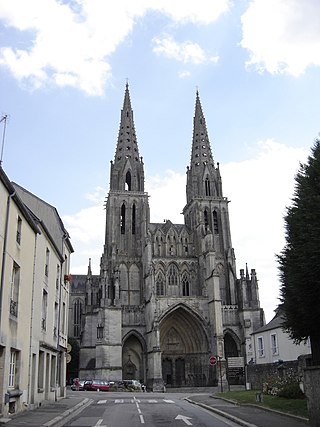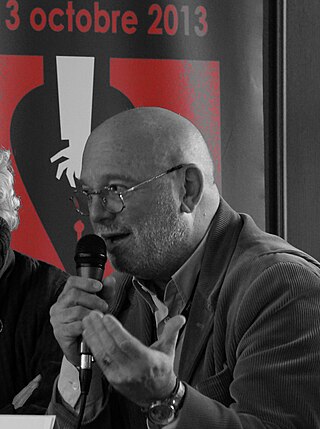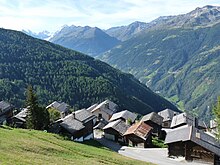
In France, a banlieue is a suburb of a large city, or all its suburbs taken collectively. Banlieues are divided into autonomous administrative entities and do not constitute part of the city proper. For instance, 80 percent of the inhabitants of the Paris metropolitan area live outside the city of Paris.

Sées is a commune in the Orne department in north-western France. It is classed as a Petites Cités de Caractère.
Magoua is a particular dialect of basilectal Quebec French spoken in the Trois-Rivières area, between Trois-Rivières and Maskinongé. Long before a military fort was constructed there, Trois-Rivières became in 1615 the first stronghold of the coureurs des bois outside the city of Québec. Magoua is the ethnonym applied to their descendants in the area. Magoua is the most conservative of all Quebec French varieties, including Joual. It preserves the sontaient ("étaient") characteristic of Métis French and Cajun French, has a creole-like past tense particle tà and has old present-tense contraction of a former verb "to be" that behave in the same manner as subject clitics.

Michel Quint is a French writer from the Nord-Pas-de-Calais.
The Château de Cerisy-la-Salle, located in the French commune of Cerisy-la-Salle, hosts the Centre culturel international de Cerisy-la-Salle (CCIC), a prestigious venue for intellectual and scholarly encounters founded in 1952 by Anne Heurgon-Desjardins. The center is the home of the famous "Colloques de Cerisy", a series of seminars which constitute an important reference in the recent history of French intellectual life. The expression "Colloque de Cerisy" also refers to the proceedings of these seminars, which are available from various publishers.
Edmond Couchot was a French digital artist and art theoretician who taught at the University Paris VIII.

Henri Meschonnic was a French poet, linguist, essayist and translator. He is remembered today as both a theoretician of language and as a translator of the Old Testament. The 710-page Critique du rythme, probably remains his most famous theoretical work. As a translator of the Old Testament he published many volumes, including Les cinq rouleaux in 1970 ; Jona et le signifiant errant in 1998 (Jonah); Gloires in 2000 (Psalms); Au commencement in 2002 (Genesis); Les Noms in 2003 (Exodus); Et il a appelé in 2005 (Leviticus); and Dans le désert in 2008 (Numbers).

Jean-Bernard Racine was a professor of geography at the Institute of Geography, Faculty of Geosciences and Environment of the University of Lausanne (UNIL) and at HEC Lausanne Business School. Racine received his first PhD in geography from the University of Aix-en-Provence (1965) and his State PhD in geography (1973) from the University of Nice. Jean-Bernard Bernard was a professor at the University of Sherbrooke between 1965 and 1969, and at the University of Ottawa from 1969 to 1973.
Pascale Ballet is a French Egyptologist, and a Professor of Art History and Archaeology of Antiquity at the University of Poitiers. The subject of her thesis obtained in June 1980 under the leadership of Jean Leclant was on terracotta figurines from Egypt and the Mediterranean in the Hellenistic and Roman times, in which she is an expert.
This is a bibliography of the history of Lyon. The history of Lyon has been deeply studied by many historians who published hundreds of books on architecture, arts, religion, etc., in Lyon throughout centuries.
A number of newspapers were produced by French prisoners in POW camps in Germany during World War I. Argus (1917) lists six such publications: Canard (Nürnberg), l'Écho des Baraques (Zwickau), Exilé (Hammelburg), Intermède (Würzburg), Le Camp de Göttingen (Göttingen) and Les Camps d'Allemagne.
Pierre Bouet is a 20th-century French historian specializing in Norman and Anglo-Norman historians of Latin language.
Jacques Heurgon was a French university, normalian, Etruscan scholar and Latinist, professor of Latin language and literature at the Sorbonne. Married to Anne Heurgon-Desjardins, founder in 1952, of the Centre culturel international de Cerisy-la-Salle, he was the father of Marc Heurgon, politician and historian, Catherine Peyrou and Edith Heurgon who continued the "Colloques of Cerisy".
Sigefroi or Sifroi (Sigefridus) was a Norman prelate of the early 11th century in what is today France.
Azonthe Venerable was a prelate of the late 10th and early 11th century.
Richard of Gloucester or Richard Fitz Robert was appointed bishop of Bayeux in France in 1138 and died in 1142. He was the eldest son of Robert, 1st Earl of Gloucester, but he was illegitimate. His mother was Isabel of Dover, daughter of Samson of Worcester, Bishop of Worcester.

Paul-Alexis Mellet is a French early modern historian and expert in the political and religious ideas from early modernity. He is a professor at the University of Geneva and a member of the Institute of Reformation History. Formerly, he was a professor at the University of Cergy-Pontoise, and at the University of Tours.
The Frozen Policeman is a 1908 French short silent film by Georges Méliès. No Star Film Company catalogue number is known for it.

Yves Winkin is a Belgian academic who spent much of his career based in France. He is known for work in communication, specifically for developing the anthropology of communication, for introducing the concept of enchantment to the social sciences, for investigating pedestrian behavior, and for his analyses of Erving Goffman's work in relation to his life. At various times, he worked with Pierre Bourdieu in France, as well as Goffman, Dell Hymes, and Ray Birdwhistell in the US, leading to his efforts to share research across international borders. In addition, he has held three kinds of administrative position.
Enchantment is a term widely used to describe something delightful, possibly magical, that causes a feeling of wonder. It has been adapted by a range of scholars across multiple disciplines, especially anthropology and sociology, and then later urban studies, to describe the ways in which people create moments of wonder in the midst of everyday life. British anthropologist Alfred Gell described art as "the technology of enchantment," permitting us to "see the real world in an enchanted form". American sociologist George Ritzer uses the term enchantment in his analysis of consumerism and McDonaldization, making the argument that "enchantment of the consumer is necessary for the spell to work".









